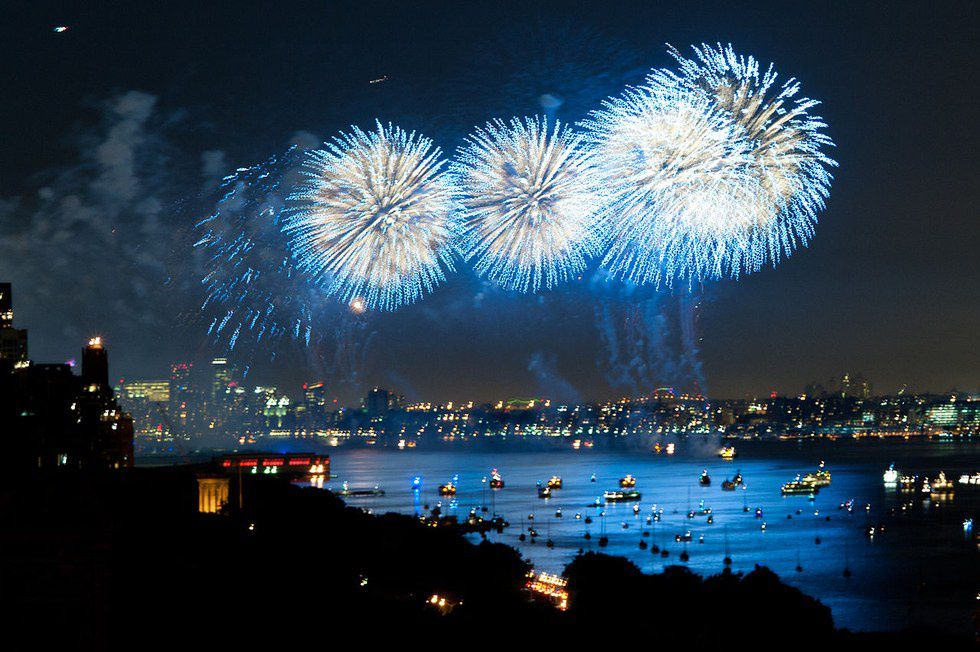Everyone knows that Independence Day marks the historical date where an iconic array of colors appear in the sky, shining bright above a sea of American flags. When I was younger, I always thought fireworks were astonishing; how, such a small device can create such a ginormous display of colors in different shapes and sizes. I always wondered how they worked, and realized many people assumed or explained that they're just a matter of gunpowder and some kind of special dye, but the truth behind how fireworks actually work is as incredible as the colors they make.
Fireworks are a magnificent creation, and they are actually quite an endeavor to produce such a lively stream of colors. It doesn't just take chemicals packed in a small cardboard container, lit by fire in an open area to trigger them; for there are an incredible amount of chemical reactions at play here.
Similar to rainbows, elements in nature give off unique colors in a rainbow, from refraction and reflections of light, and in some cases, from chemical reactions. Fireworks are a huge amount of chemical reactions occurring before our eyes. They are almost like an extraordinary science demonstration in the sky (and quite a big one at that).
It doesn't just take fire to work the magic, and some people might be surprised to find a large handful of the elements that contribute to incredible possibilities, and our entertainment on the Fourth of July, are some we are exposed to every day.
Fireworks are a reminder of how beautiful science is, and below are the many elements that have helped create the spectacular display of fireworks each year:
First and foremost, the colors:
Strontium- Strontium salts, along with lithium carbonate, form the deep red colors in fireworks. In order to create a brighter red, Strontium carbonate is needed.
Calcium- Calcium salts, and calcium chloride come together to make orange colors.
Copper- Copper compounds and copper chloride form the lucent blue that appears in fireworks. Interestingly enough, copper can mix with strontium to make purple. In other words, mixing two colors together to form another, just like in art class, works similarly with fireworks, but on the molecular level.
Sodium- Sodium salts, and sodium chloride (A.K.A. the table salt you put on your food), actually make yellow colors in fireworks.
Barium- Barium compounds and salts work both create green colors.
Magnesium- Burning this element creates silver and white colors; however, aluminum and titanium can also be burned to create this effect.
And then there's the elements responsible for the features of fireworks:
Iron- This element is the cause for the sparks in fireworks. Likewise with the other elements, the colors of the sparks are determined by heat.
Potassium Nitrate and Sulfur- Two components of gunpowder, which is an important part of fireworks, and which helps launch them into the night sky.
Oxygen- Fireworks include oxidizers, which are resources that produce oxygen. In this case, oxygen fuels the firework by accelerating the heating process of the elements.Heat is sometimes despised by people--especially the excessive heat in July--but heat should be admired for other reasons, such as being the prime reason we have such exciting possibilities like fireworks. Without the ability to heat substances, we wouldn't get the luminous colors in the night sky.
Additionally, the temperatures of the substances are important, and sometimes when manipulated, makes substances produce light. When a substance is heated, the energy levels rise, and from that more energy is being released, in this case light. Substances sometimes gives off different colors when in they're emitting energy.
As for the sounds fireworks produce, the loud noises are a result of the sudden release of an enormous amount of energy. This effect is slightly similar (but definitely not as intense), as bombs--which are also a result of a tremendous amount of energy being released. While the molecules in fireworks are in what's known as an excited state, or reacting in a chemical manner and releasing more energy: they explode. This quick release of energy creates a powerful sound wave, and the boom we hear in the sky. It's a good thing we don't explode, with all our excitement and energy from watching fireworks!
And thus, all of these molecular circumstances occur to create the beauty of fireworks. Isn't it incredible how much more is at play when it comes to fireworks than what most of us probably thought? Next time you see fireworks, keep in mind how truly amazing they are as you witness the breathtaking molecules at work in the sky.






















